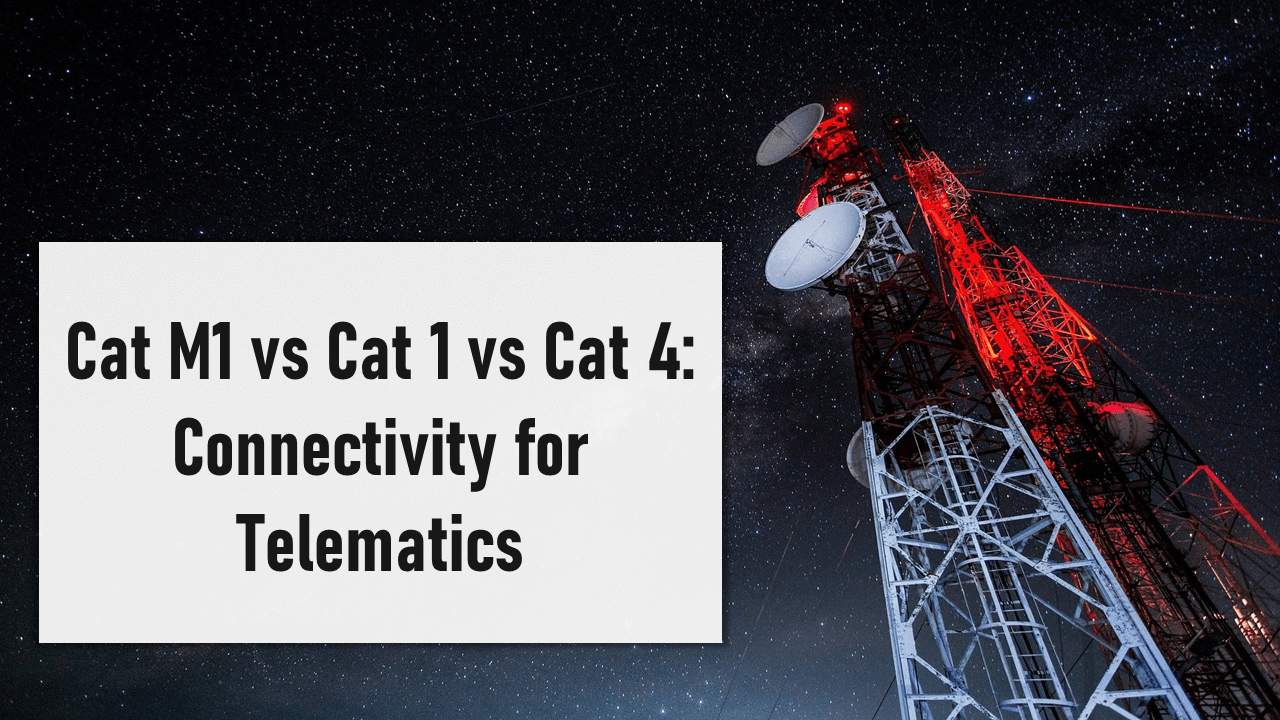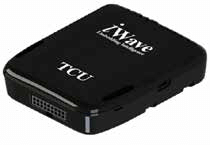Cat M1 vs Cat 1 vs Cat 4 Cellular Connectivity in Telematics Solutions
Through increased adoption of data driven telematics use cases in vehicles, there has been a rising need for telematics edge hardware across a range of vehicles.Telematics and connected vehicle solutions help unlock value across a range of vehicle types: passenger cars, heavy duty trucks, electric vehicles, boats, with the list growing day by day.
Different applications require different data processing and connectivity architectures – A few applications require more edge processing with intelligence on the device, while a few use cases require all data to pushed on to the cloud platforms to build on the analytics and dashboards.
The improvement in the connectivity landscape has enabled vehicles to be connected to the internet. Cellular technology is available from Cat 0 to Cat 19, however, the technology most suited and commonly used in telematics and connected mobility solutions are Cat M1, Cat 1 and Cat 4. A more detailed insight into these 3 connectivity technologies is given below.
A Comparison of throughput: Cat M1 vs Cat 1 vs Cat 4
Cat M1, which also goes by the name LTE Cat M1 originally was designed specifically for IoT Solutions, with an average upload and download speed of 375 kbps. There is a trade-off between lower data range and the signal rate, where in the lower data rates enable the signal to travel further, allowing for devices to be positioned in remote locations.
Cat 1 supports higher data throughput of 10Mbps, enough for a majority of telematics and IoT applications. Cat 1 offers better global coverage while supporting low latency for wake-up applications. The major attraction is that it’s already standardized, and more importantly, it’s simple to transition into the Cat 1 network.
Cat 4 modems can scream data at rates of up to 50Mbps upload and 150Mbps download speeds, which are essentially the same speeds consumers get on their smartphones.
| Cat M1 | Cat 1 | Cat 4 | |
| Bandwidth | 1.4MHz | 20MHz | 20MHz |
| Downlink | 375 kbps | 10Mbps | 150Mbps |
| Uplink | 375 kbps | 5Mbps | 50Mbps |
| Duplex | Half | Full | Full |
Coverage and Cost: Cat M1 vs Cat 1 vs Cat 4
Cat M1 is compatible with the existing LTE network, providing a slight advantage over the other options available. However, Cat M1 support is not widely available yet around the world with network operators including in their roadmap for launch soon. Taking the advantage of technological maturity and global coverage of 4G network, LTE Cat 1 has a strong and reliable network foundation to empower various IoT applications and scenarios. Cat 1 is available today and widely supported by carriers worldwide In fact, by the end of 2025, NB-IoT and Cat M1 are expected to make up 52% of all cellular IoT connections, according to the Ericsson Mobility Report in November 2019.
Since the Cat M1 band is also the same across geographies, a single SKU can support global coverage. In case of applications, where the vehicle is travelling through geographies, Cat M1 is the right connectivity module to choose.
LTE Cat 1 IoT solution presents its advantages with its amazing cost performance in the medium rate market. However, there are 2 costs to be considered – The module costs as well the recurring network costs. Cat M1 and Cat 1 can be considered as low-cost options, both from the module costing perspective as well as the recurring network costs. Cat 4 is slightly more expensive but can sometimes be the right module to choose dependent on the throughput requirements. The price difference between Cat 1 and Cat 4 modules are getting narrower through economies of scale, as module and chip vendors are beginning to consolidate requirements across customers and applications.
Use Cases: Cat M1 vs Cat 1 vs Cat 4
| Cat M1 | Cat 1 | Cat 4 |
| Smart Agriculture | Digital Signage | Video Surveillance |
| Smart Metering | ATMs | Vehicle to Vehicle Comm. |
| Navigation | Kiosks | Predictive Analytics |
| Asset Tracking | Video Surveillance | Driver Behaviour Analysis |
| Pet trackers | Vehicle Telematics | Vehicle FOTA |
| Fitness bands | Connected Healthcare | IoT Gateways |
| Environment Monitoring | Point-of-sale terminals | Network Bridges |
If your IoT use case involves maintaining an “always-on” connection between your devices and your application cloud, then a Cat 1 or Cat 4 modem is better suited for your device.
When Cat M1 technology is fully deployed, LTE for IoT will spread to the numerous types of very low throughput, very low power consumption applications such as industrial sensors, asset trackers, or wearables that wake up periodically to deliver only very small amounts of data and then go back to sleep. Cat M1 was designed primarily for efficiency. If the end application needs transmitting large data, constant connection, or high speed, then Cat M1 won’t be viable.
Cat 1 is believed to be the ideal solution for scenarios that are not dependent on high-speed data transmission but still require the reliability of the 4G network, and Cat 4 finding in a fit where there are no power budget constraints, and a requirement for high data throughput.
iWave Telematics Portfolio: Cat M1 & Cat 4 Telematics Units
Enabling customers to unlock value across a range of connected fleet, iWave supports customers with a Telematics Control Unit and Telematics Gateway. The telematics hardware is compatible with Cat M1 networks or can be configured to support Cat 4 networks, with the modem configuration an assembly configuration, making the device compatible to multiple connectivity technologies.
By integrating a pre certified connectivity modem, which has been certified across geographies such as FCC, CE, GCF & TELEC, and network operator certifications such as VERIZON, AT&T, TELSTRA, VODAFONE makes the iWave telematics unit easier to certify dependent on the geographic certification requirements.
The telematics hardware is integrated with 3 CAN Ports, IMU Sensors, Ethernet, Analog Inputs with the support for various wireless technologies such as LTE, Wi-Fi, and Bluetooth. iWave supports telematics service providers with rugged and reliable telematics hardware. We design and manufacture telematics control units, telematics gateway and V2X Connectivity Solutions to cater to the growing telematics applications.
Summary
While there is no one fit all modem for all telematics use cases, A decision considering cost, power consumption and throughput must be taken based on the end application. Since data rate requirements and power consumption are in most cases pre-determined by end application, The type of network connectivity you would need should be decided based on your desired functionality, not by the price of the LTE modem.
There are a wide range of telematics use cases, ranging from personalised infotainment, fleet management, route scheduling and predictive maintenance. Different use cases require different connectivity modems and varying levels of processing power on the edge.
Cat M1 offer many benefits, but currently have some limitations, namely, still an emerging technology, and coverage is still limited globally. Cat 1 and Cat 4 are the dominant connectivity technologies at present, which can be chosen based on the throughput and end application.
Cellular Technology: Way Forward
Soon, we can expect car manufacturers to continue advancing vehicle connectivity by further integrating smart features into telematics systems and adding functions that improve safety like emergency services, location tracking, Video Telematics, ADAS and vehicle diagnostics. Vehicles are also transitioning more to a Software-Defined Car, where new connectivity, automation, and personalization features will be increasingly implemented with software in the future. All these applications require fast data transmission, analysis, and implementation which stretches the opportunities for 5G and Cat 6. Data-transfer speed with 5G will be 10 times faster than LTE networks. This increase in speed enables telematics devices to communicate and share data faster than ever that will connect virtually everything around us. Whereas LTE Cat 6 allows transfer rates of up to 300Mbps (download) and up to 50Mbps (upload), this makes Cat 6 first category of LTE Advanced for high-end telematics use cases. Customers can choose the wireless technology which makes the most sense for their requirements and still get the high capacity, fast speed, and low latency they need to ensure devices can share data quickly and more reliably.
To get in touch with iWave for enquiries and any further information, you can reach us at mktg@iwavesystems.com.
Learn more at:
- Product Page: Telematics Control Unit
- Product Page: Telematics Gateway
Keep Reading
 |  |  |
| The importance of telematics in Electric Vehicles | How V2X technology can transform your driving experience | Telematics Gateway with J1939 Data Logging for Off-Road Vehicles |




